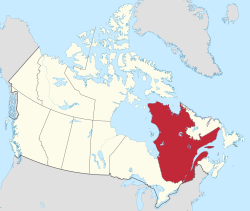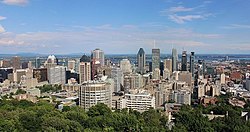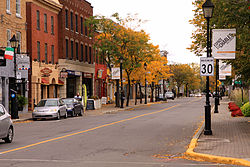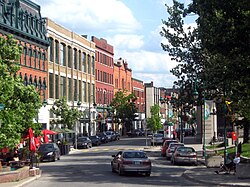






Quebec is the second-most populous province in Canada with 8,501,833 residents as of 2021 and is the largest in land area at 1,298,599.75 km2 (501,392.17 sq mi).[1] For statistical purposes, the province is divided into 1,282 census subdivisions,[2] which are municipalities and equivalents.[3] Quebec's 1,218 municipalities include 87 regional county municipalities at the supralocal level and 1,131 local municipalities (88.2% of its census subdivisions). Generally, most local municipalities, as well as some unorganized territories, are nested within regional county municipalities.[4] The 1,218 municipalities are directly responsible for the provision of public transit, fire protection, potable water, water purification, and waste management services to its residents.[4] They also share responsibility with the province in the provision of housing, road networks, police protection, recreation and culture, parks and natural spaces, and land use planning and development.[4]
Below the regional county municipality level, the Government of Quebec's Ministry of Municipal Affairs and Housing recognizes 10 types of local municipalities – cities, towns, village municipalities, parish municipalities, township municipalities, united township municipalities, Cree village municipalities, Naskapi village municipalities, northern village municipalities, and simply "municipalities".[5][6] Cities and towns are legislated primarily by the Loi sur les cités et villes (Cities and Towns Act).[7] The Cree Villages and the Naskapi Village Act presides over the province's Cree and Naskapi village municipalities,[8] while the Act Respecting Northern Villages and the Kativik Regional Government presides over northern villages.[9] The 5 other types of municipalities are legislated primarily by the Code municipal du Québec (Municipal Code of Quebec).[10] The Municipal Powers Act and 40 other pieces of legislation also apply to municipalities.[4]
Of Quebec's 1,127 local municipalities, 654 or 58% of them are simply "municipalities".[5][6] Among the remaining 473, there are 234 towns, 42 village municipalities, 131 parish municipalities, 41 township municipalities, 2 united township municipalities, 8 Cree village municipalities, 1 Naskapi village municipality, and 14 northern village municipalities.[5][6] Despite still being a legal municipal status type,[7] there are no longer any cities in Quebec,[5][2] although one town is permitted to brand itself as a city in its official name.[11]
In 2021, Quebec's local municipalities covered 38.4% of the province's land mass yet were home to 99.5% of its population.[12][a] Montreal is the province's largest municipality with 1,762,949 residents.[12] Chisasibi, Eastmain, Kawawachikamach, Nemaska, Saint-Louis-de-Gonzague-du-Cap-Tourmente, Waskaganish, Waswanipi, Wemindji, and Whapmagoostui are Quebec's smallest municipalities each with a population of 0.[12][b] The largest municipality by land area is Eeyou Istchee Baie-James at 283,123.42 km2 (109,314.56 sq mi), while the smallest by land area is Notre-Dame-des-Anges at 0.04 km2 (0.015 sq mi).[12]
- ^ "Population and dwelling counts, for Canada, provinces and territories, 2021 and 2016 censuses – 100% data". Statistics Canada. March 14, 2022. Retrieved August 17, 2022.
- ^ a b c Cite error: The named reference
2021dictionarywas invoked but never defined (see the help page). - ^ "Dictionary, Census of Population, 2021: Census subdivision (CSD)". Statistics Canada. February 28, 2022. Retrieved August 27, 2022.
- ^ a b c d "Québec Municipal Organization". Gouvernement du Québec: Affaires Municipales et Régions. December 2006. Retrieved August 27, 2022.
- ^ a b c d "Répertoire des municipalités – Nombre de municipalités : 1108". Ministry of Municipal Affairs and Housing. Retrieved August 17, 2022.
- ^ a b c "Répertoire des municipalités – Autres territoires : 179". Ministry of Municipal Affairs and Housing. Retrieved August 17, 2022.
- ^ a b "Cities and Towns Act". Gouvernement du Québec. April 1, 2022. Retrieved August 20, 2022.
- ^ "The Cree Villages and the Naskapi Village Act". Gouvernement du Québec. April 1, 2022. Retrieved August 22, 2022.
- ^ "Act Respecting Northern Villages and the Kativik Regional Government". Gouvernement du Québec. April 1, 2022. Retrieved August 22, 2022.
- ^ "Municipal Code of Quebec". Gouvernement du Québec. April 1, 2022. Retrieved August 20, 2022.
- ^ Cite error: The named reference
toponymiewas invoked but never defined (see the help page). - ^ a b c d e Cite error: The named reference
2021censuswas invoked but never defined (see the help page). - ^ "Population and Dwelling Count Highlight Tables, 2011 Census – Notes (Adjustment of population counts)". Statistics Canada. January 30, 2013. Retrieved October 31, 2013.
Cite error: There are <ref group=lower-alpha> tags or {{efn}} templates on this page, but the references will not show without a {{reflist|group=lower-alpha}} template or {{notelist}} template (see the help page).